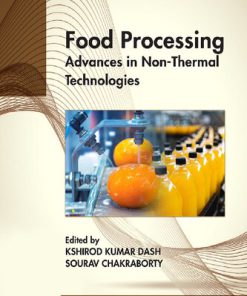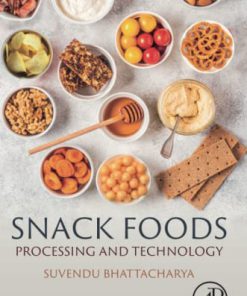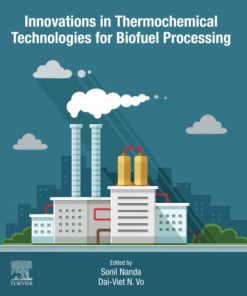Emerging Technologies in Meat Processing Production Processing and Technology 1st Edition by Enda J Cummins, James G Lyng ISBN 9781118350683 1118350685
$50.00 Original price was: $50.00.$25.00Current price is: $25.00.
Emerging Technologies in Meat Processing Production Processing and Technology 1st Edition by Enda J Cummins, James G Lyng – Ebook PDF Instant Download/Delivery: 9781118350683 ,1118350685
Full download Emerging Technologies in Meat Processing Production Processing and Technology 1st Edition after payment

Product details:
ISBN 10: 1118350685
ISBN 13: 9781118350683
Author: Enda J Cummins, James G Lyng
Emerging Technologies in Meat Processing Production Processing and Technology 1st Edition Table of contents:
Chapter 1: Emerging technologies in meat processing
1.1 Context and challenges
1.2 Book objective
1.3 Book structure
1.4 Conclusion
Part I: Novel processing techniques
Chapter 2: Irradiation of meat and meat products
2.1 Summary
2.2 Theory of irradiation of foods
2.3 Irradiation equipment
2.4 Future role for irradiation in the preservation of foods
References
Chapter 3: High-pressure processing of meat and meat products
3.1 Introduction
3.2 Theory of high-pressure preservation and decontamination of foods
3.3 High-pressure applications
3.4 High-pressure equipment
3.5 Future role for high pressure in the preservation and decontamination of foods
References
Chapter 4: Electroprocessing of meat and meat products
4.1 Introduction to electroprocessing technologies
4.2 Non-thermal electroprocessing of meat
4.3 Thermal electroprocessing (i.e. electroheating) of meat
4.4 Future of electroprocessing of meat
4.5 Equipment suppliers
Acknowledgements
References
Chapter 5: Application of infrared and light-based technologies to meat and meat products
5.1 Introduction
5.2 Theory of UV, IR, and high-intensity light pulse preservation of foods
5.3 Infrared radiation
5.4 Ultraviolet radiation
5.5 High-intensity light pulses
5.6 Future role for UV, IR, and high-intensity light pulses in the preservation of foods
References
Chapter 6: Ultrasound processing applications in the meat industry
6.1 Introduction
6.2 Fundamentals of ultrasound processing
6.3 Ultrasound processing equipment
6.4 Ultrasound for decontamination of meat
6.5 Applications of ultrasound in meat processing
6.6 Concluding remarks
References
Chapter 7: Application of hydrodynamic shock wave processing associated with meat and processed meat products
7.1 Introduction
7.2 Applicability of hydrodynamic shock waves on meat and meat products
7.3 Approaches to the generation of hydrodynamic shock waves, and the theory and mode of action relative to muscle food applications
7.4 Advantages and disadvantages of hydrodynamic shock wave
7.5 Case studies: hydrodynamic shock wave treatment of meat products
7.6 Developmental advances in hydrodynamic shock wave equipment
7.7 Brief overview of available hydrodynamic shock wave equipment and manufacturers of hydrodynamic shock wave equipment
References
Chapter 8: Robotics in meat processing
8.1 Introduction
8.2 Application of robotics in meat processing
8.3 Mechatronic and robotic systems in the food industry
8.4 Case studies
8.5 Future role for robotics in the processing of meat and meat products
References
Part II: Novel Packaging and meat functionality
Chapter 9: Packaging systems and materials used for meat products with particular emphasis on the use of oxygen scavenging systems
9.1 Introduction
9.2 Case-ready packaging
9.3 Theory of MAP/oxygen scavenging technology for meat products
9.4 Future role for novel packaging systems in the preservation of meat
References
Chapter 10: Smart packaging solutions encompassing nanotechnology
10.1 Introduction
10.2 Smart packaging
10.3 Conclusion
References
Chapter 11: Probiotic functionality in meat
11.1 Introduction
11.2 Ecology of gastrointestinal tract (GIT)
11.3 Identification of potential microorganisms
11.4 Selection of probiotics
11.5 Probiotic meat products
11.6 Functionality of probiotics
11.7 Disease prevention by probiotics
11.8 Role of probiotics in function food development
11.9 Conclusion
References
Part III: Assessment techniques for meat quality and safety
Chapter 12: Rapid methods for microbial analysis of meat and meat products
12.1 Introduction
12.2 Theory of high rapid methods
12.3 Rapid method tools
12.4 Future role for rapid methods in foods safety
References
Chapter 13: The use of hyperspectral techniques in evaluating quality and safety of meat and meat products
13.1 Introduction
13.2 Hyperspectral techniques
13.3 Applications in evaluating quality and safety of meat and meat products
13.4 Advantages and disadvantages of hyperspectral techniques in meat applications
13.5 Conclusion
Acknowledgments
References
Chapter 14: Online meat quality and compositional assessment techniques
14.1 Summary
14.2 Introduction
14.3 In vivo methods of carcass evaluation
14.4 Post-mortem compositional analysis
14.5 Conclusions
References
Chapter 15: Meat authenticity
15.1 Introduction
15.2 Theory of authenticity in the meat industry
15.3 Authenticity methods
15.4 Future role for authenticity in food
Reference
Chapter 16: Regulation and legislative issues
16.1 Introduction
16.2 Overview of principles of food regulation
16.3 Food safety regulation within the European Union
16.4 Meat inspection
16.5 Marketing challenges: reports of adverse health effects
16.6 Conclusion
People also search for Emerging Technologies in Meat Processing Production Processing and Technology 1st Edition:
meat processing research
new technology in meat processing
new meat processing technology
new technology in meat industry
chemicals used in meat processing
Tags: Enda J Cummins, James G Lyng, Emerging Technologies, Meat Processing Production
You may also like…
Politics & Philosophy - International Relations
Biology and other natural sciences - Plants: Agriculture and Forestry
Technique - Food Manufacturing
Food Processing Advances In Non Thermal Technologies Kshirod Kumar Dash
Technique - Food Manufacturing
Snack Foods: Processing and Technology 1st Edition Suvendu Bhattacharya
Technique - Food Manufacturing
Enzyme Inactivation in Food Processing: Technologies, Materials, and Applications Megh R. Goyal
Technique - Food Manufacturing
Food Processing Advances in Thermal Technologies Kshirod Kumar Dash
Uncategorized
Microwave Plasma Sources and Methods in Processing Technology 1st Edition Ladislav Bardos
Technique - Food Manufacturing
Chemistry - Technical & Industrial Chemistry











